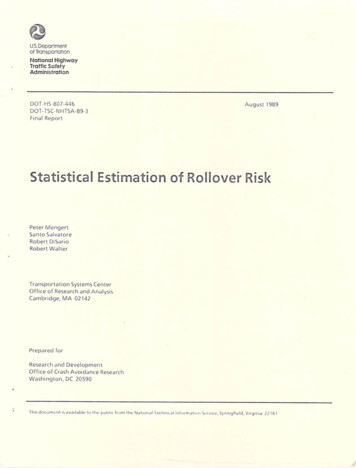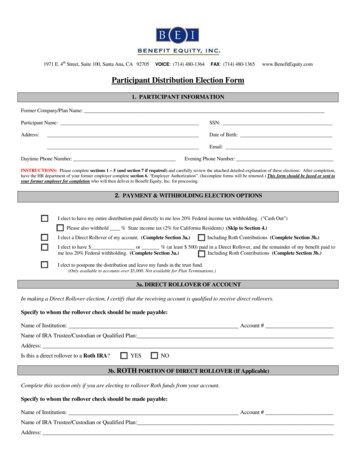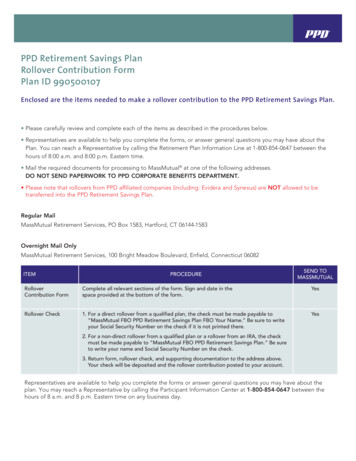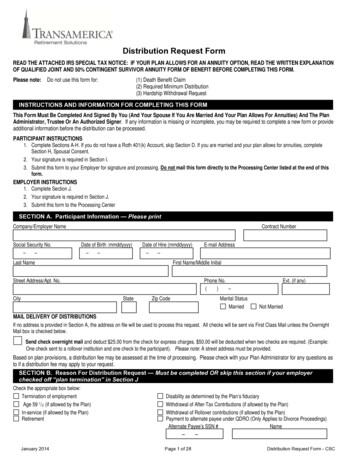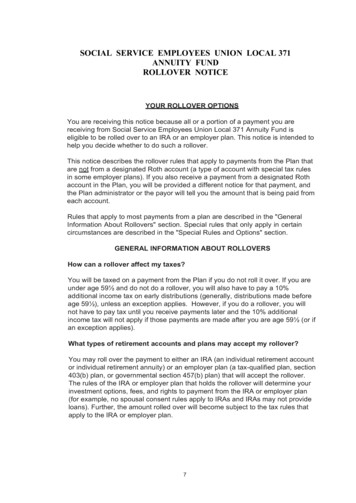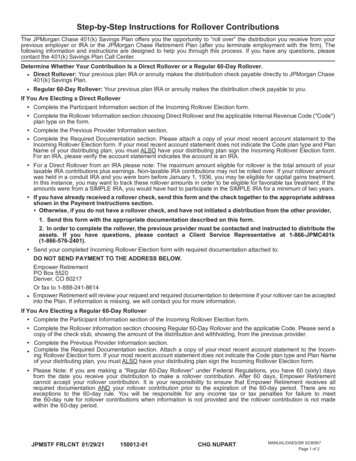
Transcription
THE JOURNAL OF FINANCE VOL. LXVII, NO. 2 APRIL 2012Rollover Risk and Credit RiskZHIGUO HE and WEI XIONG ABSTRACTOur model shows that deterioration in debt market liquidity leads to an increasein not only the liquidity premium of corporate bonds but also credit risk. The lattereffect originates from firms’ debt rollover. When liquidity deterioration causes a firmto suffer losses in rolling over its maturing debt, equity holders bear the losses whilematuring debt holders are paid in full. This conflict leads the firm to default at a higherfundamental threshold. Our model demonstrates an intricate interaction between theliquidity premium and default premium and highlights the role of short-term debt inexacerbating rollover risk.THE YIELD SPREAD OF a firm’s bond relative to the risk-free interest rate directlydetermines the firm’s debt financing cost, and is often referred to as its creditspread. It is widely recognized that the credit spread reflects not only a defaultpremium determined by the firm’s credit risk but also a liquidity premium dueto illiquidity of the secondary debt market (e.g., Longstaff, Mithal, and Neis(2005) and Chen, Lesmond, and Wei (2007)). However, academics and policymakers tend to treat both the default premium and the liquidity premiumas independent, and thus ignore interactions between them. The financialcrisis of 2007 to 2008 demonstrates the importance of such an interaction—deterioration in debt market liquidity caused severe financing difficulties formany financial firms, which in turn exacerbated their credit risk.In this paper, we develop a theoretical model to analyze the interactionbetween debt market liquidity and credit risk through so-called rollover risk:when debt market liquidity deteriorates, firms face rollover losses from issuingnew bonds to replace maturing bonds. To avoid default, equity holders needto bear the rollover losses, while maturing debt holders are paid in full. This He is with the University of Chicago, and Xiong is with Princeton University and NBER. Anearlier draft of this paper was circulated under the title “Liquidity and Short-Term Debt Crises.”We thank Franklin Allen, Jennie Bai, Long Chen, Douglas Diamond, James Dow, Jennifer Huang,Erwan Morellec, Martin Oehmke, Raghu Rajan, Andrew Robinson, Alp Simsek, Hong Kee Sul,S. Viswanathan, Xing Zhou, and seminar participants at Arizona State University, Bank ofPortugal Conference on Financial Intermediation, Boston University, Federal Reserve Bank of NewYork, Indiana University, NBER Market Microstructure Meeting, NYU Five Star Conference, 3rdPaul Woolley Conference on Capital Market Dysfunctionality at London School of Economics, Rutgers University, Swiss Finance Institute, Temple University, Washington University, 2010 WesternFinance Association Meetings, University of British Columbia, University of California–Berkeley,University of Chicago, University of Oxford, and University of Wisconsin at Madison for helpfulcomments. We are especially grateful to Campbell Harvey, an anonymous associate editor, and ananonymous referee for extensive and constructive suggestions.391
392The Journal of Finance Rintrinsic conflict of interest between debt and equity holders implies that equityholders may choose to default earlier. This conflict of interest is similar inspirit to the classic debt overhang problem described by Myers (1977) and hasbeen highlighted by Flannery (2005) and Duffie (2009) as a crucial obstacleto recapitalizing banks and financial institutions in the aftermath of variousfinancial crises, including the recent one.We build on the structural credit risk model of Leland (1994) and Lelandand Toft (1996). Ideal for our research question, this framework adopts theendogenous-default notion of Black and Cox (1976) and endogenously determines a firm’s credit risk through the joint valuation of its debt and equity.When a bond matures, the firm issues a new bond with the same face valueand maturity to replace it at the market price, which can be higher or lowerthan the principal of the maturing bond. This rollover gain/loss is absorbedby the firm’s equity holders. As a result, the equity price is determined by thefirm’s current fundamental (i.e., the firm’s value when it is unlevered) and expected future rollover gains/losses. When the equity value drops to zero, thefirm defaults endogenously and bond holders can only recover their debt byliquidating the firm’s assets at a discount.We extend this framework by including an illiquid debt market. Bond holdersare subject to Poisson liquidity shocks. Upon the arrival of a liquidity shock,a bond holder has to sell his holdings at a proportional cost. The trading costmultiplied by bond holders’ liquidity shock intensity determines the liquidity premium in the firm’s credit spread. Throughout the paper, we take bondmarket liquidity as exogenously given and focus on the effect of bond market liquidity deterioration (due to either an increase in the trading cost or anincrease in investors’ liquidity shock intensity) on the firm’s credit risk.A key result of our model is that, even in the absence of any constraint onthe firm’s ability to raise more equity, deterioration in debt market liquiditycan cause the firm to default at a higher fundamental threshold due to thesurge in the firm’s rollover losses. Equity holders are willing to absorb rolloverlosses and bail out maturing bond holders to the extent that the equity value ispositive, that is, the option value of keeping the firm alive justifies the cost ofabsorbing rollover losses. Deterioration in debt market liquidity makes it morecostly for equity holders to keep the firm alive. As a result, not only does theliquidity premium of the firm’s bonds rise, but also their default probabilityand default premium.Debt maturity plays an important role in determining the firm’s rolloverrisk. While shorter maturity for an individual bond reduces its risk, shortermaturity for all bonds issued by a firm exacerbates its rollover risk by forcing itsequity holders to quickly absorb losses incurred by its debt financing. Lelandand Toft (1996) numerically illustrate that shorter debt maturity can lead afirm to default at a higher fundamental boundary. We formally analyze thiseffect and further show that deterioration in market liquidity can amplify thiseffect.Our calibration shows that deterioration in market liquidity can have asignificant effect on credit risk of firms with different credit ratings and debt
Rollover Risk and Credit Risk393maturities. If an unexpected shock causes the liquidity premium to increaseby 100 basis points, the default premium of a firm with a speculative grade Brating and 1-year debt maturity (a financial firm) would rise by 70 basis points,which contributes to 41% of the total credit spread increase. As a result of thesame liquidity shock, the increase in default premium contributes to a 22.4%increase in the credit spread of a BB rated firm with 6-year debt maturity (anonfinancial firm), 18.8% for a firm with an investment grade A rating and1-year debt maturity, and 11.3% for an A rated firm with 6-year debt maturity.Our model has implications for a broad set of issues related to firms’ creditrisk. First, our model highlights debt market liquidity as a new economic factorfor predicting firm default. This implication can help improve the empiricalperformance of structural credit risk models (e.g., Merton (1973), Leland (1994),Longstaff and Schwartz (1995), and Leland and Toft (1996)), which focus on theso-called distance to default (a volatility-adjusted measure of firm leverage) asthe key variable driving default. Debt market liquidity can also act as a commonfactor in explaining firms’ default correlation, a phenomenon that commonlyused variables such as distance to default and trailing stock returns of firmsand the market cannot fully explain (e.g., Duffie et al. (2009)).Second, the intrinsic interaction between liquidity premia and default premia derived from our model challenges the common practice of decomposingfirms’ credit spreads into independent liquidity-premium and default-premiumcomponents and then assessing their quantitative contributions (e.g., Longstaffet al. (2005), Beber, Brandt, and Kavajecz (2009), and Schwarz (2009)). Thisinteraction also implies that, in testing the effect of liquidity on firms’ creditspreads, commonly used control variables for default risk such as the creditdefault swap spread may absorb the intended liquidity effects and thus causeunderestimation.Third, by deriving the effect of short-term debt on firms’ rollover risk,our model highlights the role of the so-called maturity risk, whereby firmswith shorter average debt maturity or more short-term debt face greater default risk. As pointed out by many observers (e.g., Brunnermeier (2009) andKrishnamurthy (2010)), the heavy use of short-term debt financing such ascommercial paper and overnight repos is a key factor in the collapse of BearStearns and Lehman Brothers.Finally, our model shows that liquidity risk and default risk can compoundeach other and make a bond’s betas (i.e., price exposures) with respect to fundamental shocks and liquidity shocks highly variable. In the same way thatgamma (i.e., variability of delta) reduces the effectiveness of discrete deltahedging of options, the high variability implies a large residual risk in bondinvestors’ portfolios even after an initially perfect hedge of the portfolios’ fundamental and liquidity risk.Our paper complements several recent studies on rollover risk. Acharya,Gale, and Yorulmazer (2011) study a setting in which asset owners have nocapital and need to use the purchased risky asset as collateral to secure shortterm debt funding. They show that the high rollover frequency associated withshort-term debt can lead to diminishing debt capacity. In contrast to their
394The Journal of Finance Rmodel, our model demonstrates severe consequences of short-term debt evenin the absence of any constraint on equity issuance. This feature also differentiates our model from Morris and Shin (2004, 2010) and He and Xiong (2010),who focus on rollover risk originated from coordination problems between debtholders of firms that are restricted from raising more equity. Furthermore,by highlighting the effects of market liquidity within a standard credit-riskframework, our model is convenient for empirical calibrations.The paper is organized as follows. Section I presents the model setting. InSection II, we derive the debt and equity valuations and the firm’s endogenousdefault boundary in closed form. Section III analyzes the effects of marketliquidity on the firm’s credit spread. Section IV examines the firm’s optimalleverage. We discuss the implications of our model for various issues relatedto firms’ credit risk in Section V and conclude in Section VI. The Appendixprovides technical proofs.I. The ModelWe build on the structural credit risk model of Leland and Toft (1996) byadding an illiquid secondary bond market. This setting is generic and appliesto both financial and nonfinancial firms, although the effects illustrated by ourmodel are stronger for financial firms due to their higher leverage and shorterdebt maturities.A. Firm AssetsConsider a firm. Suppose that, in the absence of leverage, the firm’s assetvalue {Vt : 0 t } follows a geometric Brownian motion in the risk-neutralprobability measuredVt (r δ) dt σ dZt ,Vt(1)where r is the constant risk-free rate,1 δ is the firm’s constant cash payout rate,σ is the constant asset volatility, and {Zt : 0 t } is a standard Brownianmotion, representing random shocks to the firm’s fundamental. Throughoutthe paper, we refer to Vt as the firm’s fundamental.2When the firm goes bankrupt, we assume that creditors can recover only afraction α of the firm’s asset value from liquidation. The bankruptcy cost 1 αcan be interpreted in different ways, such as loss from selling the firm’s real1 In this paper, we treat the risk-free rate as constant and exogenous. This assumption simplifiesthe potential flight-to-liquidity effect during liquidity crises.2 As in Leland (1994), we treat the unlevered firm value process {V : 0 t } as the exogetnously given state variable to focus on the effects of market liquidity and debt maturity. In ourcontext, this approach is equivalent to directly modeling the firm’s exogenous cash flow process{φVt : 0 t } as the state variable (i.e., the so-called EBIT model advocated by Goldstein, Ju,and Leland (2001)). For instance, Hackbarth, Miao, and Morellec (2006) use this EBIT modelframework to analyze the effects of macroeconomic conditions on firms’ credit risk.
Rollover Risk and Credit Risk395assets to second-best users, loss of customers because of anticipation of thebankruptcy, asset fire-sale losses, legal fees, etc. An important detail to keep inmind is that the liquidation loss represents a deadweight loss to equity holdersex ante, but ex post is borne by debt holders.B. Stationary Debt StructureThe firm maintains a stationary debt structure. At each moment in time, thefirm has a continuum of bonds outstanding with an aggregate principal of Pand an aggregate annual coupon payment of C. Each bond has maturity m, andexpirations of the bonds are uniformly spread out over time. This implies that,1dt of the bonds matures and needsduring a time interval (t, t dt), a fraction mto be rolled over.We measure the firm’s bonds by m units. Each unit thus has a principalvalue ofp Pm(2)c C.m(3)and an annual coupon payment ofThese bonds differ only in the time-to-maturity τ [0, m]. Denote by d(Vt , τ )the value of one unit of a bond as a function of the firm’s fundamental Vt andtime-to-maturity τ .Following the Leland framework, we assume that the firm commits to astationary debt structure denoted by (C, P, m). In other words, when a bondmatures, the firm will replace it by issuing a new bond with identical maturity,principal value, and coupon rate. In most of our analysis, we take the firm’sleverage (i.e., C and P) and debt maturity (i.e., m) as given; we discuss thefirm’s initial optimal leverage and maturity choices in Section IV.C. Debt Rollover and Endogenous BankruptcyWhen the firm issues new bonds to replace maturing bonds, the market priceof the new bonds can be higher or lower than the required principal paymentsof the maturing bonds. Equity holders are the residual claimants of the rollovergains/losses. For simplicity, we assume that any gain will be immediately paidout to equity holders and any loss will be paid off by issuing more equity at themarket price. Thus, over a short time interval (t, t dt), the net cash flow toequity holders (omitting dt) isNCt δVt (1 π ) C d (Vt , m) p.(4)The first term is the firm’s cash payout. The second term is the after-tax couponpayment, where π denotes the marginal tax benefit rate of debt. The thirdand fourth terms capture the firm’s rollover gain/loss by issuing new bonds
396The Journal of Finance Rto replace maturing bonds. In this transaction, there are dt units of bondsmaturing. The maturing bonds require a principal payment of pdt. The marketvalue of the newly issued bonds is d(Vt , m)dt. When the bond price d(Vt , m)drops, equity holders have to absorb the rollover loss [d(Vt , m) p]dt to preventbankruptcy.When the firm issues additional equity to pay off the rollover loss, the equityissuance dilutes the value of existing shares. As a result, the rollover loss feedsback into the equity value. This is a key feature of the model—the equity valueis jointly determined by the firm’s fundamental and expected future rollovergains/losses.3 Equity holders are willing to buy more shares and bail out thematuring debt holders as long as the equity value is still positive (i.e., theoption value of keeping the firm alive justifies the expected rollover losses).The firm defaults when its equity value drops to zero, which occurs when thefirm fundamental drops to an endogenously determined threshold VB. At thispoint, the bond holders are entitled to the firm’s liquidation value αVB, whichin most cases is below the face value of debt P.To focus on the liquidity effect originating from the debt market, we ignoreany additional frictions in the equity market such as transaction costs andasymmetric information. It is important to note that, while we allow the firmto freely issue more equity, the equity value can be severely affected by thefirm’s debt rollover losses. This feedback effect allows the model to capturedifficulties faced by many firms in raising equity during a financial marketmeltdown even in the absence of any friction in the equity market.We adopt the stationary debt structure of the Leland framework, that is,newly issued bonds have identical maturity, principal value, coupon rate, andseniority as maturing bonds. When facing rollover losses, it is tempting for thefirm to reduce rollover losses by increasing the seniority of its newly issuedbonds, which dilutes existing debt holders. Leland (1994) illustrates a dilution effect of this nature by allowing equity holders to issue more pari passubonds. Since doing so necessarily hurts existing bond holders, it is usuallyrestricted by bond covenants (e.g., Smith and Warner (1979)).4 However, in3 A simple example works as follows. Suppose a firm has one billion shares of equity outstanding,and each share is initially valued at 10. The firm has 10 billion of debt maturing now, and,because of an unexpected shock to the bond market liquidity, the firm’s new bonds with the sameface value can only be sold for 9 billion. To cover the shortfall, the firm needs to issue more equity.As the proceeds from the share offering accrue to the maturing debt holders, the new shares dilutethe existing shares and thus reduce the market value of each share. If the firm only needs to rollover its debt once, then it is easy to compute that the firm needs to issue 1/9 billion shares andeach share is valued at 9. The 1 price drop reflects the rollover loss borne by each share. If thefirm needs to rollover more debt in the future and the debt market liquidity problem persists, theshare price should be even lower due to the anticipation of future rollover losses. We derive suchan effect in the model.4 Brunnermeier and Oehmke (2010) show that, if a firm’s bond covenants do not restrict thematurity of its new debt issuance, a maturity rat race could emerge as each debt holder would demand the shortest maturity to protect himself against others’ demands to have shorter maturities.As shorter maturity leads to implicit higher priority, this result illustrates a severe consequenceof not imposing priority rules on future bond issuance in bond covenants.
Rollover Risk and Credit Risk397practice covenants are imperfect and cannot fully shield bond holders from future dilution. Thus, when purchasing newly issued bonds, investors anticipatefuture dilution and hence pay a lower price. Though theoretically interestingand challenging, this alternative setting is unlikely to change our key result: ifdebt market liquidity deteriorates, investors will undervalue the firm’s newlyissued bonds (despite their greater seniority), which in turn will lead equityholders to suffer rollover losses and default earlier.5 Pre-committing equityholders to absorb ex post rollover losses can resolve the firm’s rollover risk.However, this resolution violates equity holders’ limited liability. Furthermore,enforcing ex post payments from dispersed equity holders is also costly.Under the stationary debt structure, the firm’s default boundary VB isconstant, which we derive in the next section. As in any trade-off theory,bankruptcy involves a deadweight loss. Endogenous bankruptcy is a reflection of the conflict of interest between debt and equity holders: when the bondprices are low, equity holders are not willing to bear the rollover losses necessary to avoid the deadweight loss of bankruptcy. This situation resemblesthe so-called debt overhang problem described by Myers (1977), as equity holders voluntarily discontinue the firm by refusing to subsidize maturing debtholders.D. Secondary Bond MarketsWe adopt a bond market structure similar to that in Amihud and Mendelson(1986). Each bond investor is exposed to an idiosyncratic liquidity shock, whicharrives according to a Poisson occurrence with intensity ξ. Upon the arrival ofthe liquidity shock, the bond investor has to exit by selling his bond holdingin the secondary market at a fractional cost of k. In other words, the investoronly recovers a fraction 1 k of the bond’s market value.6 We shall broadly5 Diamond (1993) presents a two-period model in which it is optimal (even ex ante) to make refinancing debt (issued at intermediate date 1) senior to existing long-term debt (which matures atdate 2). In that model, better-than-average firms want to issue more information-sensitive shortterm debt at date 0. Because making refinancing debt more senior allows more date-0 short-termdebt to be refinanced, it increases date-0 short-term debt capacity. Although the information-drivenpreference of short-term debt is absent in our model, this insight does suggest that making refinancing debt senior to existing debt can reduce the firm’s rollover losses. However, the two-periodsetting considered by Diamond misses an important issue associated with recurring refinancing ofreal-life firms. To facilitate our discussion, take the infinite horizon setting of our model. Supposethat newly issued debt is always senior to existing debt, that is, the priority rule in bankruptcy nowbecomes inversely related to the time-to-maturity of existing bonds. This implies that newly issued bonds, while senior to existing bonds, must be junior to bonds issued in the future. Therefore,although equity holders can reduce rollover losses at the default boundary (because debt issuedright before default is most senior during the bankruptcy), they may incur greater rollover losseswhen further away from the default boundary (because bonds issued at this time are likely to bejunior in a more distant bankruptcy). The overall effect is unclear and worth exploring in futureresearch.6 As documented by a series of empirical papers (e.g., Bessembinder, Maxwell, and Venkataraman (2006), Edwards, Harris, and Piwowar (2007), Mahanti et al. (2008), and Bao, Pan, and Wang(2011)), the secondary markets for corporate bonds are highly illiquid. The illiquidity is reflected
398The Journal of Finance Rattribute this cost to either the market impact of the trade (e.g., Kyle (1985)),or the bid-ask spreads charged by bond dealers (e.g., Glosten and Milgrom(1985)).While our model focuses on analyzing the effect of external market liquidity,it is also useful to note the importance of firms’ internal liquidity. By keepingmore cash and acquiring more credit lines, a firm can alleviate its exposure tomarket liquidity.7 By allowing the firm to raise equity as needed, our modelshuts off the internal-liquidity channel and instead focuses on the effect ofexternal market liquidity. It is reasonable to conjecture that the availabilityof internal liquidity can reduce the effect of market liquidity on firms’ creditspreads. However, internal liquidity holdings cannot fully shield firms fromdeterioration in market liquidity as long as internal liquidity is limited.8 Indeed, as documented by Almeida et al. (2009) and Hu (2011), during the recentcredit crisis nonfinancial firms that happened to have a greater fraction oflong-term debt maturing in the near future had more pronounced investmentdeclines and greater credit spread increases than otherwise similar firms. Thisevidence demonstrates the firms’ reliance on market liquidity despite theirinternal liquidity holdings. We leave a more comprehensive analysis of theinteraction between internal and external liquidity for future research.II. Valuation and Default BoundaryA. Debt ValueWe first derive bond valuation by taking the firm’s default boundary VB asgiven. Recall that d (Vt , τ ; VB) is the value of one unit of a bond with a timeto-maturity of τ m, an annual coupon payment of c, and a principal value ofp. We have the following standard partial differential equation for the bondvalue:rd (Vt , τ ) c ξ kd (Vt , τ ) d (Vt , τ ) 1 2 2 2 d (Vt , τ ) d (Vt , τ ) (r δ ) Vt σ Vt. τ V2 V 2(5)by a large bid-ask spread that bond investors have to pay in trading with dealers, as well as apotential price impact of the trade. Edwards et al. (2007) show that the average effective bid-askspread on corporate bonds ranges from 8 basis points for large trades to 150 basis points for smalltrades. Bao et al. (2011) estimate that, in a relatively liquid sample, the average effective tradingcost, which incorporates bid-ask spread, price impact, and other factors, ranges from 74 to 221basis points depending on the trade size. There is also large variation across different bonds withthe same trade size.7 Bolton, Chen, and Wang (2011) recently model firms’ cash holdings as an important aspect oftheir internal risk management. Campello et al. (2010) provide empirical evidence that, duringthe recent credit crisis, nonfinancial firms used credit lines to substitute cash holdings to financetheir investment decisions.8 In particular, when the firm draws down its credit lines, issuing new ones may be difficult,especially during crises. Acharya, Almeida, and Campello (2010) provide evidence that aggregaterisk limits availability of credit lines and Murfin (2010) shows that a shock to a bank’s capitaltends to cause the bank to tighten its lending.
Rollover Risk and Credit Risk399The left-hand side rd is the required (dollar) return from holding the bond.There are four terms on the right-hand side, capturing expected returns fromholding the bond. The first term is the coupon payment. The second term isthe loss caused by the occurrence of a liquidity shock. The liquidity shock hitswith probability ξ dt. Upon its arrival, the bond holder suffers a transactioncost of kd (Vt , τ ) by selling the bond holding. The last three terms capture theexpected value change due to a change in time-to-maturity τ (the third term)and a fluctuation in the value of the firm’s assets Vt (the fourth and fifth terms).By moving the second term to the left-hand side, the transaction cost essentiallyincreases the discount rate (i.e., the required return) for the bond to r ξ k, thesum of the risk-free rate r and a liquidity premium ξ k.We have two boundary conditions to pin down the bond price based on equation (5). At the default boundary VB, bond holders share the firm’s liquidationvalue proportionally. Thus, each unit of bond getsd(VB, τ ; VB) αVB,mfor all τ [0, m].(6)When τ 0, the bond matures and its holder gets the principal value p if thefirm survives:d(Vt , 0; VB) p, for all Vt VB.(7)Equation (5) and boundary conditions (6) and (7) determine the bond’s value: cαVBcc (r ξ k)τd(Vt , τ ; VB) p e(1 F(τ )) G(τ ),r ξkr ξkmr ξk(8)where F(τ ) N (h1 (τ )) G (τ ) h1 (τ ) VtVB a zVtVB 2aN (h2 (τ )) ,N (q1 (τ )) VtVB a zN (q2 (τ )) ,( vt aσ 2 τ )( vt aσ 2 τ ), h2 (τ ) , σ τσ τzσ 2 τ )zσ 2 τ )( vt ( vt , q2 (τ ) , σ τσ τ r δ σ 2 /2Vt[a2 σ 4 2(r ξ k)σ 2 ]1/2, a , z ,vt lnVBσ2σ2q1 (τ ) (9) xy2and N (x ) 12π e 2 dy is the cumulative standard normal distribution.This debt valuation formula is similar to the one derived in Leland and Toft(1996) except that market illiquidity makes r ξ k the effective discount ratefor the bond payoff.
The Journal of Finance R400The bond yield is typically computed as the equivalent return on a bondconditional on its being held to maturity without default or trading. Given thebond price derived in equation (8), the bond yield y is determined by solvingd (Vt , m) c(1 e ym) pe ym,y(10)where the right-hand side is the price of a bond with a constant coupon paymentc over time and a principal payment p at the bond maturity, conditional on nodefault or trading before maturity. The spread between y and the risk-freerate r is often called the credit spread of the bond. Since the bond price inequation (8) includes both trading cost and bankruptcy cost effects, the creditspread contains a liquidity premium and a default premium. The focus of ouranalysis is to uncover the interaction between the liquidity premium and thedefault premium.B. Equity Value and Endogenous Default BoundaryLeland (1994) and Leland and Toft (1996) indirectly derive equity value asthe difference between total firm value and debt value. Total firm value is theunlevered firm’s value Vt , plus the total tax benefit, minus the bankruptcycost. This approach does not apply to our model because part of the firm’s valueis consumed by future trading costs. Thus, we directly compute equity valueE (Vt ) through the following differential equation:r E (r δ ) Vt EV 1 2 2σ Vt EV V δVt (1 π ) C d (Vt , m) p.2(11)The left-hand side is the required equity return. This term should be equal tothe expected return from holding the equity, which is the sum of the terms onthe right-hand side. The first two terms (r δ ) Vt EV 12 σ 2 Vt2 EV V capture the expected changein equity value caused by a fluctuation in the firm’s asset value Vt . The third term δVt is cash flow generated by the firm per unit of time. The fourth term (1 π ) C is the after-tax coupon payment per unit of time. The fifth and sixth terms d (Vt , m) p capture equity holders’ rollovergain/loss from paying off maturing bonds by issuing new bonds at themarket price.Limited liability of equity holders provides the following boundary conditionat VB: E (VB) 0. Solving the differential equation in (11) is challenging because it contains the complicated bond valuation function d (Vt , m) given in (8).We manage
between debt market liquidity and credit risk through so-called rollover risk: when debt market liquidity deteriorates, firms face rollover losses from issuing new bonds to replace maturing bonds. To avoid default, equity holders need to bear the rollover losses, while maturing debt holders are paid in full. This
